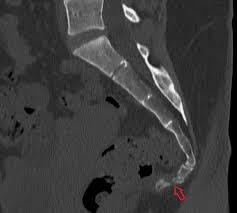Common Conditions
Coccydynia
Coccydynia, or tailbone pain, refers to discomfort or pain in the coccyx, the small triangular bone at the base of the spine. The coccyx helps support the body while sitting and serves as an attachment point for various ligaments and muscles. Pain in this area can range from mild discomfort to severe pain that interferes with daily activities, especially when sitting or transitioning from sitting to standing.

Coccydynia can result from several factors, including:
- Injury or trauma: A fall onto the buttocks, direct blow, or prolonged pressure on the coccyx (tail bone) can lead to pain or bruising.
- Childbirth: During delivery, the coccyx may be strained or injured, leading to postpartum tailbone pain.
- Prolonged sitting: Sitting for extended periods on hard or uncomfortable surfaces can strain the coccyx.
- Degenerative changes: Age-related or arthritis in the adjacent joints around the sacrum and coccyx can cause coccydynia.
- Repetitive strain: Activities including cycling, repetitive sit ups or rowing can put repetitive stress on the coccyx.
Common symptoms of coccydynia
Symptoms of coccydynia may include:
- Localized pain: An aching, sharp, or throbbing midline pain at the base of the spine, often worse when sitting.
- Pain when moving: Activities including standing up from a seated position, bending, or sitting for long periods can aggravate the pain.
- Tenderness: The area around the coccyx may feel tender to the touch. Occasionally a subcutaneous bursa develops.
Diagnosis of coccydynia
Diagnosis of coccydynia typically begins with a discussion of your symptoms and a physical examination. There is significant genetic variation in the shape, position and angulation of the coccyx.
During the exam, the doctor will gently press on the coccyx to check for local tenderness. A rectal examination is not usually indicated.
Imaging tests may be used if symptoms are severe, persistent, or follow trauma. These may include:
- CT scan/X-rays to detect fractures, dislocations, or bone alignment issues – especially following acute injury.
- MRI scans to assess surrounding soft tissues and rule out other causes of pain, such as infection or tumours.
Management of coccydynia
Management of coccydynia focuses on relieving pain and reducing strain on the coccyx. Common approaches include:
- Avoiding prolonged sitting: Taking breaks or using a “donut” cushion with a cut-out section reduces pressure on the coccyx with sitting.
- Medications: Over-the-counter pain relievers such as paracetamol or anti-inflammatories can help manage discomfort.
- Injections: Radiology guided local anaesthetic and corticosteroid injections may provide temporary relief for severe or persistent coccydynia.
- Radiofrequency neurotomy: Ablating the nerves of the coccyx can be undertaken in some cases and can provide medium term relief of symptoms.
- Lifestyle modifications: Maintaining good posture and avoiding activities that worsen the pain can aid recovery.
- Surgical options: In rare cases, if conservative treatments fail, surgical removal of the coccyx (coccygectomy) may be considered.
- Physiotherapy or manipulative treatments: These therapies have minimal role in the treatment of uncomplicated coccydynia.

